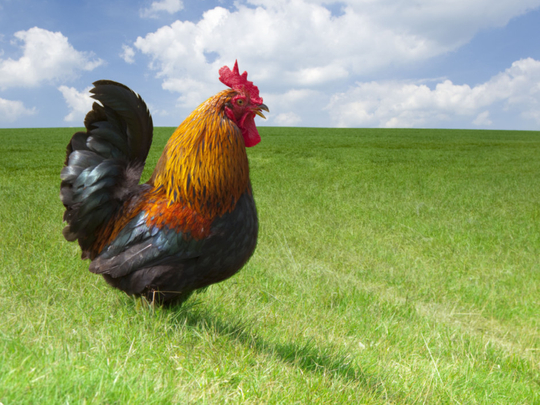
WASHINGTON
More than 2,000 years ago, the inhabitants of a settlement in what is now eastern England did something that might seem totally unremarkable: They put a chicken in a pot.
What’s notable is that they did not cook or eat the chicken. Archaeologists who later unearthed the site in Lincolnshire County found the chicken’s skeleton intact and concluded that it had been carefully buried by its Iron Age handlers, perhaps as an offering to the gods, or perhaps because it was seen as godlike itself. After all, chickens, the descendants of Asian jungle fowl, had only been in Britain for a few hundred years, and they were loud, colourful and still rare.
This was an exotic bird. A special bird.
Today, when it comes to humans’ relationship with chickens, things could hardly be more different. About 20 billion chickens, mostly white, live on farms around the world. Their meat and eggs are a huge and growing source of protein for people in the United States and globally. Idioms like “ruling the roost” permeate the English language. But despite chickens’ ubiquity — or perhaps because of it — some of us aren’t even sure they are birds.
“When you see chickens up in a tree branch, people think it’s funny or Photoshopped, but they’re birds and they do go in trees,” said a US neuroscientist Lori Marino, who has long researched animal intelligence. “Chickens are on the bottom of the scale in terms of people recognising who they are.”
But they’re now getting a bit of respect from academics who argue that these fowl have been given short shrift. About two dozen researchers in England, funded by a $3 million grant from the Arts and Humanities Research Council of Great Britain, are wrapping up a three-year project tracing the arc of human interaction with chickens — animals that project leader Naomi Sykes says “changed the world.”
Marino, an expert on dolphins and other species more commonly thought of as smart, recently published a paper on the peer-reviewed scientific literature on chicken cognition, emotion and sociality. Her conclusion is that they’re far from birdbrained, but we’ve given them little chance to prove it.
Surprising skills
That’s because most studies of chickens reflect their status as commodities and are about egg production or flock management, Marino said. But her review reveals some surprising chicken skills. Five-day-old chicks display basic addition and subtraction abilities.
Hens have demonstrated transitive inference, or the ability to deduce that if A is bigger than B and B is bigger than C, then A is bigger than C. That’s considered a milestone for 7-year-old children. Hens do it via their pecking order: Subordinates know that if a dominant hen is successfully challenged by a strange hen, they’d best not approach the stranger.
Chickens can also be conniving, Marino explains: Roosters sometimes make a call falsely indicating to hens that food is around, just to lure them away from other males (though the females usually get wise to this and adopt the counter-strategy of ignoring the males). Chickens’ food calls are among about two dozen vocalisations that convey distinct meanings, and using them is called “referential communication.”
“When we found it in monkeys many years ago, it was a big thing. We didn’t think other animals are capable of referential communication,” said Marino, whose paper was published in the journal Animal Cognition. “Now we’re seeing a lot of parallels between chickens and a lot of the mammals that we think of as very intelligent.”
There’s been a similar lack of focus on chickens across other academic fields, said Sykes, a University of Nottingham archaeologist. Her own interest in the birds came after she began keeping some, and she realised they — by providing eggs, clucking around the garden and, well, fertilising it — were having a “huge influence” on her life.
“I thought, ‘Wow, this is incredible!’ No one thinks about chickens in the archaeological record. No one considers them,” Sykes said. “I think it’s because they’re everywhere in our society now. They’ve become meaningless.”
Rise of industrial farming
With the grant funding, archaeologists, biologists, anthropologists, historians and others have been examining the history of chickens’ domestication, which happened at least 5,000 years ago, as well as their travels around the globe.
That spread appears to have been driven not by a demand for their meat — the original birds were quite scrawny — but for cockfighting, Sykes said.
The Romans probably ate them sometimes, said Greger Larson, a University of Oxford evolutionary biologist who is another project leader. But, he explained, chicken dinners only became common with the rise of Christianity and an 11th century monk-inspired craze for fasts that prohibited the meat of four-legged animals.
“For that reason, everyone wants chickens, and they want fish,” Larson said.
Yet nothing has changed human-chicken relations like the rise of industrial farming over the past century. Now, instead of scratching around our yards, the vast majority of chickens are inside cages, and they are bred to grow quickly and amply.
That has made chicken meat far cheaper and more available, which has been good for people, Sykes said. But it also has meant that, in the developed world at least, people most often encounter chickens “in bits of cellophane at the supermarket,” Larson said.
Of course, in the United States and Europe, backyard chickens are trendy, and animal welfare activists have been winning battles to get egg-laying hens and, increasingly, broiler chickens better living conditions. Does that mean our coexistence with these birds is shifting again?
Sykes and Larson said they are not convinced, citing the cognitive dissonance that allows people to look fondly upon chickens while eating more of them than ever — what Larson refers to as the “multiplicity” of our relationships to them. Marino agreed.
“Where those two things meet, if they ever do, I don’t know,” she said. She intended her paper in part as a call for more research on the inner lives of chickens. For what it’s worth, she wrote, there’s no evidence that intense breeding has changed their cognitive abilities.
The chicken “is so immersed in our culture and so distinct as a domesticated animal,” Larson said. “And yet we don’t really give it its due, despite the fact that it’s permeated our lives for thousands of years.”
— Washington Post












